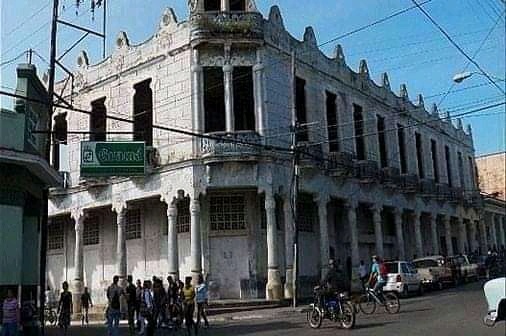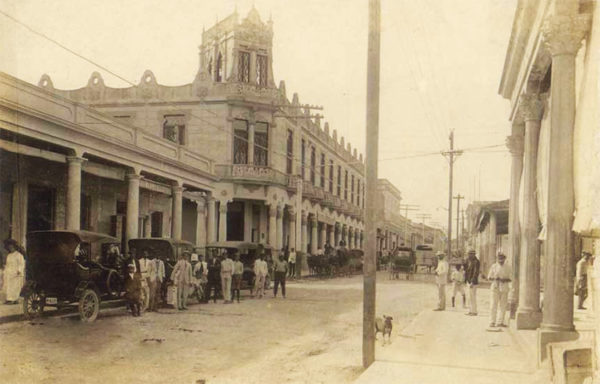A Stain in Pinar del Rio City
By Fabiana del Valle
HAVANA TIMES – Art Nouveau is in danger of extinction in Pinar del Rio’s architecture. Located in the city center, on the corner of Marti and Velez Caviedes streets, is the ruin of one of the most important buildings in the province, from an architectural point of view. What used to be the Hotel Comercio is now considered by many to be a stain that taints the city’s image, something that needs to be erased.
“It needs to be knocked down, it’s just ugly,” a friend told me. A fragment from that song I used to listen to as a child came to mind, which asked for a little love for things that are ugly.

I understand that this would be the most practical solution for my friend, and the sad thing is that most people think like this. Ever since we were children, we’ve seen places that deserved better attention from the government fall into ruin, as they’ve proven to be completely incompetent in urban management.
Despite its significant decline, this building is still bold with a style that can’t be found in other buildings, including those in the capital, at least before 1904, when it was created. This was an early date for Art Nouveau in Cuba, so it could be considered the first building constructed in this architectural style in our country.
No budgets for maintenance and repairs and a total lack of concern have uprooted the elements that identify the city. Many old buildings are about to collapse, and others have changed their function. This has all led me to do a little research.
The history of “Hotel Comercio” dates back to the mid-19th century.
There used to be a variety store on this corner, in 1870. Between 1880-1883, the provisional chapel of the San Rosendo Parish Church was located here, up until the current Cathedral was completed on December 11, 1903.
On December 9, 1891, this house was bought by Gustavo Garcia Artidiello, who knocked down the old house to build another building in its place, known back then as “Palacio Gustavo”. It was completed in 1904 and was overseen by Andalusian architect Anibal Gonzalez.
The top floors of the building were turned into a hotel and restaurant. Stairs were located on Marti street. There was a supplies warehouse on the lower floors. Once the warehouse disappeared, a store dedicated to tailoring and furs began to operate.
There were also different stores on the ground floor, over different periods of time. There was a store dedicated to selling musical instruments, and a store specializing in fine glassware. At the back of the building, there was a distillery and a cock fighting pen. On the side, on Velez Caviedes street, the “El Heraldo Pinareño” newspaper had its offices, and there was also an inn, butcher’s, fishmonger’s, business consultancy office and an insurance company.

In 1932, the building underwent several changes. It was converted into a restaurant/kitchen, a large open space to sell drinks and later a ticket office for Special Buses covering the Pinar del Rio-Havana route, which had their bus park next to the building.
The entrance on Marti Street was replaced by a beautiful marble staircase between the restaurant and the open space, which led to the hotel’s rooms. From this date onwards, it changed its name from “Palacio de Gustavo” to “Hotel Comercio”.
Today, only the part where the Pinar del Rio Art Museum is in good condition. This space has also held other installations, such as the first gallery or painting exhibition room, for example, until November 2001 when it was transformed into this important cultural institution.
In short, we have a city that is mourning the loss of traditional historic, architectural, urban and cultural values. Political and civic organizations show very little concern or say that there is a shortage of resources to remodel or take care of these buildings, which leads to the decline of the urban landscape. This is why the “Hotel Comercio” continues in shabby ruins on the corner of Marti and Velez Caviedes streets.
This place saddens me, which with its distinct Art Nouveau architectural style is being called ugly. That is why every time I go to the city, I stop for a few minutes to look at it and imagine it in its full glory, in another era. Meanwhile, it is a mute testimony of Pinar del Rio’s history and of the tired steps of a people who must hit the streets every day for their daily bread.






Thanks Fabiana, it is valuable for those of us who visit Cuba from time to time to see some of these architectural gems. I hope that with improvements to the economy, architectural treasures like the Hotel Comercio will get the attention that they deserve. There is so much interesting architecture in Cuba but so much else that also needs attention including family housing. Articles like this will help build the necessary support to protect Cuba’s history.
Traces of happier times must be removed!
I’m Cuban living in the US now for over 40+ years. It makes me sad to see beautiful buildings being torn down. They say they don’t have money I’m talking about the communist government but yet they have plenty of money to build new expensive 5-Star Hotels. They don’t care about their people so you think their going to care about an old building?